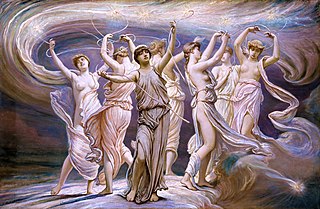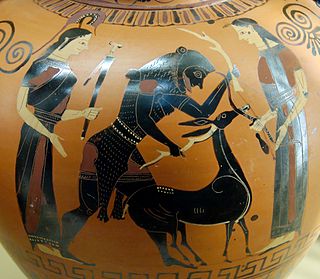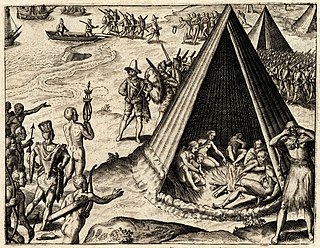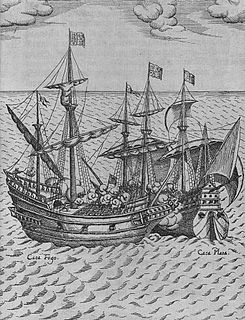
Sir Francis Drake was an English explorer, sea captain, privateer, naval officer, and politician. Drake is best known for his circumnavigation of the world in a single expedition, from 1577 to 1580. This included his incursion into the Pacific Ocean, until then an area of exclusive Spanish interest, and his claim to New Albion for England, an area in what is now the American state of California. His expedition inaugurated an era of conflict with the Spanish on the western coast of the Americas, an area that had previously been largely unexplored by Western shipping.

In Classical Greek mythology, Taygete was a nymph, one of the Pleiades according to the Bibliotheca (3.10.1) and a companion of Artemis, in her archaic role as potnia theron, "Mistress of the animals", with its likely roots in prehistory. Mount Taygetos in Laconia, dedicated to the goddess, was her haunt.

In Greek mythology, the Ceryneian hind, was a mythical creature that lived in Ceryneia, Greece and took the form of an enormous female deer, larger than a bull,with golden antlers like a stag, hooves of bronze or brass, a "dappled hide", "excelled in swiftness of foot" and snorted fire. To bring it back alive to Eurystheus in Mycenae was the third labour of Heracles.
A hind is a female deer, especially a red deer.

Golden Hind was a galleon captained by Francis Drake in his circumnavigation of the world between 1577 and 1580. She was originally known as Pelican, but Drake renamed her mid-voyage in 1578, in honour of his patron, Sir Christopher Hatton, whose crest was a golden hind. Hatton was one of the principal sponsors of Drake's world voyage. A full-sized, seaworthy reconstruction exists in London, on the south bank of the Thames.

Deer have significant roles in the mythology of various peoples located all over the world, such as object of worship, the incarnation of deities, the object of heroic quests and deeds, or as magical disguise or enchantment/curse for princesses and princes in many folk and fairy tales.

New Albion, also known as Nova Albion, was the name of the continental area north of Mexico claimed by Sir Francis Drake for England when he landed on the North American west coast in 1579. This claim became the justification for English charters across America to the Atlantic coast and soon influenced further national expansion projects on the continent. Today, Drake's landing site is known as Point Reyes, California, a marine environment which is the setting of several small towns, ranches, and Point Reyes National Seashore.

Nuestra Señora de la Concepción was a 120-ton Spanish galleon that sailed the Peru–Panama trading route during the 16th century. This ship has earned a place in maritime history not only by virtue of being Sir Francis Drake's most famous prize, but also because of her colourful nickname, Cagafuego ("fireshitter").

Sir Francis Drake is a 1961–1962 British adventure television series starring Terence Morgan as Sir Francis Drake, commander of the sailing ship the Golden Hind. As well as battles at sea and sword fights, the series also deals with intrigue at Queen Elizabeth's court.

The Golden Hinde is a mountain located in the Vancouver Island Ranges on Vancouver Island, British Columbia, Canada. The peak is popular with experienced backcountry-climbers, having been first ascended in 1913. The mountain is made of basalt which is part of the Karmutsen Formation.

The Vancouver Island Ranges, formerly called the Vancouver Island Mountains, are a mountain range extending along the length of Vancouver Island which has an area of 31,788 km² (12,273 sq; mi). The Vancouver Island Ranges comprise the central and largest part of the island. The Geological Survey of Canada refers to Vancouver Island, Haida Gwaii, and the Alaska Panhandle as the Insular Belt including the sea floor out to 100 km (62 mi) west of Vancouver Island. The Vancouver Island Ranges are a sub-range of the Insular Mountains.

Doctor Thomas Hinde was Northern Kentucky's first physician, a member of the British Royal Navy, an American Revolutionary, personal physician to Patrick Henry, and treated General Wolfe when he died in Quebec, Canada.

Cape Arago State Park is a state park in the U.S. state of Oregon, administered by the Oregon Parks and Recreation Department. Cape Arago is north of Bandon and 15 miles southwest of Coos Bay on Cape Arago Highway in Coos County.
Hinde is an English surname. Notable persons with that surname include:

Sidney Langford Hinde,, Chevalier de l'ordre royal du lion; Membre honoraire de la Société belge de géographie; Medical Officer of the Interior, British East Africa; Late Captain, Congo Free State Forces; was a military medical officer involved in colonial operations in the Congo and East Africa in the 19th century.

Mount Sir Francis Drake, 2,705 metres (8,875 ft), is a mountain in the Pacific Ranges of British Columbia, Canada, standing above the south side of Waddington Harbour and the head of Bute Inlet on the Central Coast of British Columbia just south of the mouth of the Homathko River as it empties into that harbour and inlet.
The Bishop River is a river in the Pacific Ranges of the Coast Mountains, flowing west from the western edge of the Lillooet Icecap to join the Southgate River east of the Homathko Icefield. Bishop River Provincial Park surrounds the upper course of the river, from the source at the Lillooet Icecap to midway along its course above its confluence with the Southgate.

The Golden Hinde is a full-size replica of the Golden Hind. She was built using traditional handicrafts in Appledore, Torridge. She has travelled more than 140,000 mi (230,000 km), a distance equal to more than five times around the globe. Like the original ship, she has circumnavigated the globe.

Francis Drake's circumnavigation, also known as Drake's Raiding Expedition, was an important historical maritime event that took place between 15 December 1577 and 26 September 1580. Authorised by Queen Elizabeth I and led by Francis Drake; the latter sailed with five ships in what was termed a 'voyage of discovery', although in effect it was an ambitious covert raiding voyage and the start of England's challenge to Spain's global domination.














